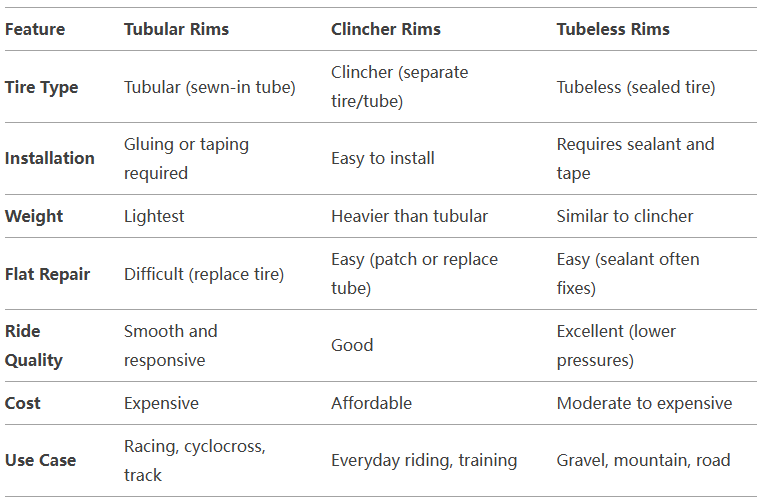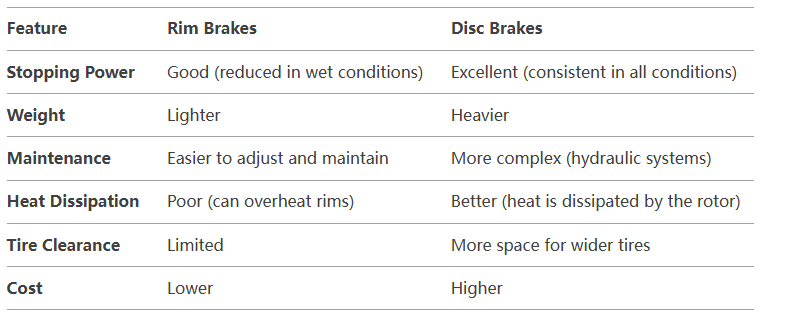When it comes to cycling performance, one component can make all the difference. Carbon wheels are the go-to for riders seeking an edge in aerodynamics, weight, and ride quality. In this article, we'll explore the ins and outs of choosing the right carbon wheels for your cycling adventures.
About the benefits of the carbon wheels,we have talked in previous articles.You can find it here>>>
Firstly you should understand carbon rim types.We explain the differences between clincher, tubular, and tubeless-ready carbon rims, helping you make an informed choice based on your riding preferences. It is essential to understanding the various rim types.Here is the three main types and their respective advantages and considerations. Clincher rims are the most common type, compatible with regular tires and inner tubes. They are easy to maintain and are user-friendly for most cyclists.Tubular rims are designed to work with tubular tires, which are completely different from the more common clincher tires.Tubular rims are favored by professional riders due to their lightweight construction.A tubular tire is a tube sewn inside a tire casing, forming a single unit. The tire is then glued or taped onto the rim, creating a secure bond.Tubeless-ready rims are designed to work with tubeless tires, which form an airtight seal with the rim when properly installed. These rims have specific features that make them compatible with tubeless systems.Tubeless-ready rims offer the best of both worlds. They can be used with tubeless tires, providing a balance between performance and convenience. They're gaining popularity for their ability to reduce flats and enhance ride quality.

The depth and profile of your carbon wheels play a very critical role in their performance. Wheel depth and profile are critical factors that influence the performance, handling, and aerodynamics of a bicycle. Whether you're a competitive racer, a gravel enthusiast, or a casual rider, understanding these aspects can help you choose the right wheels for your needs. Wheel profile refers to the shape and design of the rim, particularly its cross-section. The profile affects how the wheel interacts with the air, influencing aerodynamics, stability, and handling.For example, V-shaped rims are aerodynamic and stable, while U-shaped rims provide better handling in crosswinds.
Bicycle wheels brake systems have rim brakes and disc brakes. We explain each brake system, guiding you to the right choice for your cycling needs.Choosing the appropriate braking system is crucial when selecting your carbon wheels.
Rim brake:Rim brakes are one of the most traditional and widely used braking systems in cycling. They work by applying friction directly to the rim of the wheel to slow down or stop the bicycle. Rim brakes function by using brake pads to grip the rim of the wheel, creating friction that slows down or stops the bike. When the rider pulls the brake lever, a cable (or hydraulic system) activates the brake calipers, which squeeze the brake pads against the rim.
Advantages of rim brakes:lighter weight,Easy to install, adjust, and maintain.Works well with traditional wheel designs and is widely available.
Disadvantages of rim brakes:Less effective in wet or muddy conditions compared to disc brakes.Over time, the brake pads can wear down the rim, potentially leading to rim failure if not monitored.
Disc brake:Disc brakes are a modern braking system used in bicycles.They provide superior stopping power and performance compared to traditional rim brakes, especially in challenging conditions.Disc brakes have become increasingly popular in the cycling world, particularly for mountain bikes, gravel bikes, and high-performance road bikes.Disc brakes function by using a rotor (a metal disc attached to the wheel hub) and calipers (which hold the brake pads). When the rider pulls the brake lever, the calipers squeeze the brake pads against the rotor, creating friction that slows down or stops the bike.
Advantages of disc brake:Disc brakes provide consistent and powerful braking in all conditions, including wet, muddy, or steep terrain.Hydraulic disc brakes offer precise control over braking force, allowing for smoother stops.Since braking occurs at the rotor, the rim is not worn down over time.Rotors dissipate heat more effectively than rims, reducing the risk of overheating on long descents.Disc brakes allow for more tire clearance, making them ideal for gravel, mountain, and adventure bikes.
Disadvantages of disc brake:Disc brake systems are generally heavier than rim brakes.More expensive to purchase and maintain, especially hydraulic systems.Rotors can bend or become contaminated, affecting braking performance.

Choose the right carbon wheels,enjoy your cycling adventures.


